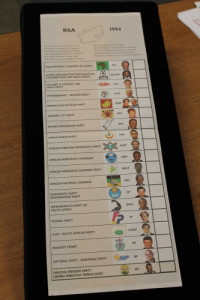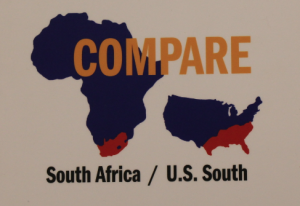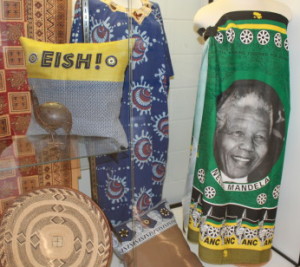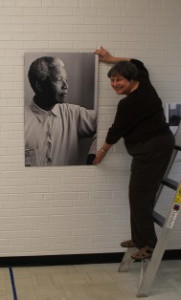An earlier version of this story did not give credit to Hilary Lindler for providing the loan of the Amy Biehl materials and the 1994 election ballot to the exhibit. It has been corrected.
Living in a country where democracy is so often taken for granted, it’s difficult to imagine a time and place where democracy was not a concept. Having the chance to view a ballot from the first South African democratic election is an opportunity that few people can say they’ve had.
Members of the WCU community are being given a chance to see an original ballot from the 1994 election and many other examples of South African history.
Inspired by the university’s 2-year theme, ‘Africa! More than a Continent’, WCU’s Mountain Heritage Center is displaying an exhibit titled ‘From Apartheid to Democracy.’
The exhibit includes a panel exhibit about the effects of apartheid on the country of South Africa and the Pieces of art and representations of South African culture are also included in the exhibit.
Apartheid was a system of race segregation that took place throughout South Africa from 1948 until the country’s first democratic election on April 27, 1994. The Afrikaans (white Dutch-German descendants) National Party that governed South Africa enforced apartheid during this time. The distribution of race in South Africa during apartheid was 76.4 percent black, 12.6 percent white, 8.5 percent colored and 2.5 percent Asian. This indicates that 12.6 percent of the population was controlling all of South Africa at the time.
During the apartheid, schools, restrooms, transportation, even sidewalks were segregated based on race. Interracial marriage was not allowed and there were strict limits on where black people could live.

A ballot from the first South African democratic election in 1994 is part of the Mountain Heritage Center’s Apartheid exhibit. It was loaned to the museum by Hilary Lindler. Photo by Haley Smith.
Pam Meister, curator and interim director of the Mountain Heritage Center, said she enjoyed the opportunity to learn about the history and culture of South Africa.
“It pushed [the Mountain Heritage Center] out of our comfort zone, but it’s been fascinating learning things about this continent, and in particular the country of South Africa,” said Meister. “It’s been a great voyage of discovery for me, personally.”
The exhibit is based on an exhibition at the Apartheid Museum in Johannesburg, South Africa and adapted for a U.S. tour by the Levine Museum of the New South in Charlotte, N.C.
Nelson Mandela was the first South African-educated black lawyer who, using Gandhi’s nonviolent approach, fought for race equality throughout apartheid. He was sentenced to life in prison after he organized a wing of the African National Conference (ANC) that harmed government property and incited violence.
Mandela remained a leader of the anti-apartheid movement in South Africa throughout his time in prison. South African President F.W. de Klerk began demolishing apartheid when he was elected in 1989 and he ordered the release of Mandela in 1990. Mandela was released from prison after 27 years and he became the first democratically elected president of South Africa in 1994.
The exhibit pays tribute to Mandela’s life, his efforts to end apartheid in South Africa and his global impact. Every part of the exhibit reflects Mandela. There are panels devoted to his struggles and passion for racial equality. Fabrics and artwork contain images of Mandela’s face. Most importantly, the ballot from 1994 lists Mandela as a presidential candidate.
Meister said the exhibit has given her a chance to see “direct parallels of what went on in South Africa and what went on, and is sometimes still going on, in the United States.”

The exhibit uses this geographic comparison of South Africa and the U.S. South to describe the similarities and differences between them. Photo by Haley Smith.
According to the exhibit, the 1960s Black Power movement in the U.S. inspired South Africa’s Black Consciousness.
The exhibit describes apartheid as “more brutal and long-lasting than Jim Crow in the U.S. South.”
The last four years of apartheid were the most violent, with 14,000 deaths due to political fighting.
Meister divulged an inspiring story about an American graduate student named Amy Biehl, who studied at the University of Cape Town in 1993. (You can listen to Amy Biehl’s story in the video at the end of the article.)
“In addition to expanding your mind and learning about a place and history that you didn’t know about before, another really powerful message of this exhibit is the whole business of ‘forgiveness’,” explained Meister, referring to the process of ‘reconciliation’ that Mandela pushed for as a president of apartheid-free South Africa.
Meister said she is amazed that, when the blacks came into power in South Africa, they did not take out their anger on the white people. Instead, they decided to “become a nation, share power and work together.”
“That very powerful story gives us the opportunity to bring in our favorite things – culture and crafts and music,” said Meister.
Katy Ginanni, an acquisitions librarian at WCU, loaned several pieces from South Africa to the apartheid exhibit and she hopes that it will “motivate people to act” on racism issues in the U.S.
“I think it’s a really important exhibit,” said Ginanni. “I think one of the things that South Africa has done well in the past that we have not done in the United States is address, head-on, the conflict between all of the different ethnic groups. Sure, there’s still racism there and there’s still problems, but at least they have talked about it in the open.”
Ginanni said she hopes the exhibit will “open people’s eyes a bit more than just reading about [apartheid] in a dry history book.”

A few of the items loaned to the exhibit by Katy Ginanni. “I love the Nelson Mandela fabric,” said Ginanni. “When I lived in Zimbabwe, the local women would take pieces of fabric to wrap around their clothes if they didn’t want to get them dirty.” Photo by Haley Smith.
Ginanni lived in South Africa for nearly two years, and she collected many pieces during her travels around the country. She spent a lot of time immersed in African culture, having also served in Zimbabwe during her time with the Peace Corps.
According to Ginanni, Apartheid also represents events that have occurred throughout the history of the entire continent of Africa.
The apartheid exhibit conveys a strong feeling of both triumph and compassion that people everywhere could benefit from.
“This lesson of freedom, forgiveness, justice and equity for all is one that we should never forget,” said Meister. “I think right now, in the election year and with some of the viciousness that is going on, this story really puts into perspective what is happening in our country.”
According to Meister, the Levine Museum has created parallels, not only between what occurred in South Africa and what occurred in the United States, but more specifically things that occurred in North Carolina.
Meister said the Mountain Heritage Center has received a few questions about what the exhibit has to do with ‘mountain heritage.’
“We are an academic museum and we want to participate in the university’s overall academic initiatives, of which this is one,” said Meister. “We are dealing with universal themes here and we are also dealing with themes that have a direct impact on Appalachian history and culture.”
The Mountain Heritage Center is helping to make the connection to Appalachia by putting together a side exhibit discussing Cherokee voting rights.
In 1920, many of the offices in Jackson County were won by Republican candidates due to the large number of Cherokee voters. Democrats protested this, saying that the Cherokee should not be eligible to vote. This issue was left unresolved until the late 1940s. Much like the Apartheid, the Cherokee were segregated based on their race and limitations were placed on them by whites. This exhibit should draw parallels between the two issues and help to connect apartheid to North Carolina.
“Cherokee people, who have served faithfully in the military throughout both World Wars, were being denied the right to vote in county elections,” said Meister. “They were told that they are part of a sovereign nation, so they couldn’t be a citizen of the county too.”

Pam Meister, curator and interim director of the Mountain Heritage Center, stands next to a photo of Nelson Mandela in the apartheid exhibit. Photo by Haley Smith.
Meister said the Mountain Heritage Center is looking into other programming to go along with the apartheid exhibit such as movies or music.
“We use our exhibits as teaching tools, both for WCU and for K-12 school groups,” said Meister. “There’s about a seven county region that comes to see our stuff.”
According to Meister, there is a recent trend in museums to do ‘pop-up exhibits’, where members of a community bring items that fit into a specified theme and contribute to a temporary exhibit.
“It’s kind of like the museum equivalent of a flash mob,” said Meister. “With all of these people telling me about their South African stuff and experiences, I think it would be really fun to put together a pop-up exhibit called ‘The South Africa Connection’.”
Ginanni is on the committee for the university’s Africa theme.
“It’s been a little difficult for us because we didn’t have a big opening event like we did for the poverty theme a few years ago,” said Ginanni. “It’s also a little difficult, because there’s so many countries and regions within Africa, so I think its been hard to pinpoint what we want to focus on.”
“I think its’ coming together and I think next year we will see even more activity. It’s such a diverse place,” said Ginanni.
This exhibit is one of many opportunities for community members to learn more about the history and culture of African countries during WCU’s Africa theme.
The exhibit will be open at no cost to the public until May 20.
Hear the story on Amy Biehl through the voice of Pam Meister. Amy Biehl materials were loaned to the exhibit by Hilary Lindler.


